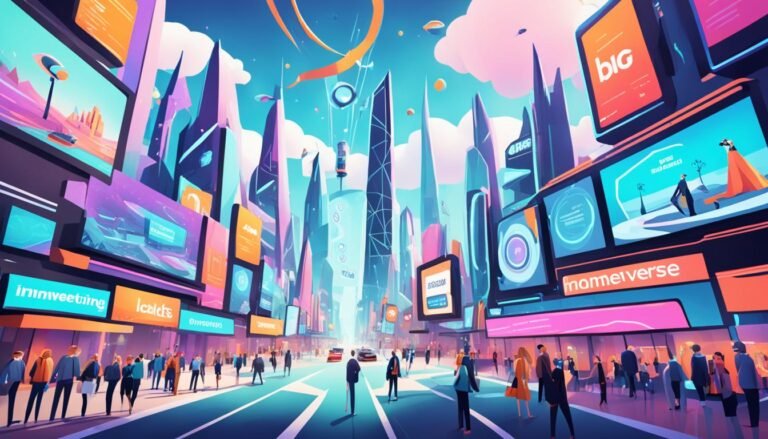Marketing Future: Preparing for What’s Next
Imagine a world where marketing is no longer a guessing game. Instead, you have the power to predict consumer behavior, harness data for smarter strategies, and create personalized experiences. It may sound like a futuristic dream, but it’s the reality of the marketing future.
In this article, we’ll explore how you can prepare for what’s next in the ever-evolving world of marketing. Get ready to embrace the irony of today’s marketing landscape and discover the path to success.
Key Takeaways
- Businesses need to embrace digital transformation and integrate emerging technologies to stay competitive in the future of marketing.
- Understanding and anticipating consumer behavior trends, such as sustainability preferences, is essential for successful marketing strategies.
- Data-driven decision making and personalization based on customer data are crucial for optimizing marketing campaigns and driving better results.
- Social media plays a significant role in brand growth and engagement, and businesses should develop a social media strategy to reach and connect with their target audience.
Emerging Technologies: Adapting to the Digital Revolution
You need to adapt to the digital revolution by embracing emerging technologies. In today’s fast-paced world, digital transformation is no longer an option but a necessity for businesses to stay relevant and competitive. The rapid advancements in technology have given rise to disruptive technologies that are revolutionizing industries across the globe.
Digital transformation involves integrating digital technologies into every aspect of your business, fundamentally changing how you operate and deliver value to your customers. It’s about leveraging emerging technologies to optimize processes, enhance customer experiences, and drive innovation. By embracing these technologies, you can unlock new opportunities and gain a competitive edge in the market.
Disruptive technologies, such as artificial intelligence, blockchain, and the internet of things, are reshaping the business landscape. They’re changing the way we communicate, collaborate, and consume information. These technologies have the potential to revolutionize industries, disrupt traditional business models, and create new markets.
To adapt to the digital revolution, it’s crucial to stay informed about emerging technologies and their potential impact on your industry. Invest in research and development to explore how these technologies can be integrated into your business. Embrace a culture of innovation and agility to respond quickly to changing market dynamics. By embracing emerging technologies, you can position your business for success in the digital era.
Consumer Behavior Shifts: Understanding and Anticipating Trends
As a marketer, you must stay ahead of the game and understand the ever-changing landscape of consumer behavior. Emerging consumer preferences are shifting the way people buy and interact with brands.
To effectively navigate this new terrain, you need to anticipate trends and predict future buying habits. By staying proactive and strategic in your approach, you can position your brand to thrive in the face of these consumer behavior shifts.
Emerging Consumer Preferences
When it comes to understanding and anticipating trends, it’s crucial to pay attention to emerging consumer preferences.
One of the key factors driving these preferences is the increasing demand for sustainable products. Consumers are becoming more conscious of their environmental impact and are seeking out products that align with their values.
This shift in consumer behavior isn’t only driven by a desire to protect the planet, but also by changing demographics. Younger generations, such as millennials and Gen Z, are entering the consumer market and they prioritize sustainability in their purchasing decisions.
As these demographics continue to grow and gain purchasing power, businesses must adapt and offer sustainable options to remain competitive.
Understanding and catering to these emerging consumer preferences will be instrumental in shaping the future of marketing.
Predicting Future Buying Habits
Fortunately, by analyzing current consumer behavior patterns and leveraging predictive analytics, you can successfully anticipate future buying habits.
With the rapid advancements in future technology and the changing demographics, it’s crucial for businesses to stay ahead of the curve. Understanding and anticipating trends in consumer behavior is key to gaining a competitive edge in the market.
By utilizing predictive analytics, you can identify patterns and trends that will help you make informed decisions about future buying habits. This data-driven approach allows you to tailor your marketing strategies to meet the evolving needs and preferences of your target audience.
Harnessing the Power of Data: Insights for Smarter Marketing
You can achieve smarter marketing by harnessing the power of data. In today’s digital age, businesses have access to vast amounts of data that can provide valuable insights for making data-driven decisions and optimizing marketing campaigns. By leveraging this data effectively, you can gain a competitive edge and drive better results.
Data-driven decision making is the process of using data and analytics to guide business strategies and make informed choices. It involves collecting, analyzing, and interpreting data to uncover patterns, trends, and customer behaviors. With the right tools and technologies, you can gather data from various sources such as online platforms, social media, customer feedback, and sales transactions. This data can then be analyzed to gain valuable insights into your target audience, their preferences, and purchasing habits.
By understanding your customers better through data, you can optimize your marketing campaigns to deliver more personalized and targeted experiences. For example, you can segment your audience based on demographics, behavior, or purchase history and tailor your messaging and offers accordingly. This level of personalization can significantly improve customer engagement and conversion rates.
Furthermore, data can help you identify trends and patterns that can guide your marketing strategies. By analyzing data on customer preferences, market trends, and competitor activities, you can make more informed decisions and allocate your marketing resources more effectively. This data-driven approach allows you to optimize your campaigns, identify areas for improvement, and drive better results.
The Rise of Personalization: Creating Tailored Experiences
How can businesses create tailored experiences through the rise of personalization?
In today’s competitive market, it’s crucial for companies to understand the power of creating customized and personalized experiences for their customers. By tailoring marketing campaigns to meet the unique needs and preferences of each individual, businesses can establish stronger connections and drive greater engagement.
Here are four strategies to consider:
-
Data-driven approach: Leverage customer data and analytics to gain insights into individual preferences, behaviors, and buying patterns. This data can help businesses understand their customers on a deeper level and create personalized experiences that resonate with them.
-
Segmentation and targeting: Divide your customer base into different segments based on demographic, psychographic, or behavioral characteristics. By targeting specific segments with tailored messages and offers, businesses can deliver more relevant and personalized experiences.
-
Personalized content: Develop content that speaks directly to your customers’ interests, needs, and pain points. Whether it’s through personalized emails, website content, or social media campaigns, delivering relevant and timely information will enhance the customer experience and increase engagement.
-
Automation and AI: Utilize automation tools and artificial intelligence to deliver personalized experiences at scale. From chatbots that provide personalized recommendations to email automation that sends targeted offers, leveraging technology can streamline the process of delivering tailored experiences.
Embracing Social Media: Leveraging Platforms for Brand Growth
To achieve brand growth, embrace social media as a platform for leveraging your brand. In today’s digital landscape, social media has become an essential tool for businesses to connect with their audience, build brand awareness, and drive sales.
One of the most effective strategies for leveraging social media is by partnering with influencers. These individuals have built a loyal following and can help amplify your brand’s message to a wider audience. By collaborating with influencers who align with your brand values and target market, you can tap into their network and gain valuable exposure.
Additionally, leveraging social media analytics is crucial for understanding your audience and optimizing your marketing efforts. By analyzing data on customer demographics, engagement rates, and content performance, you can make informed decisions about your social media strategy and improve your brand’s online presence. Social media analytics can also provide valuable insights into the effectiveness of your influencer partnerships, helping you measure the impact and return on investment.
Artificial Intelligence in Marketing: Automating and Enhancing Strategies
As you look ahead to the future of marketing, it’s crucial to consider the role of Artificial Intelligence (AI) in automating and enhancing your strategies.
AI can revolutionize personalization by analyzing large amounts of data and tailoring marketing messages to individual customers.
Additionally, AI can improve customer targeting by identifying patterns and trends in consumer behavior, allowing you to reach the right audience at the right time.
Lastly, the integration of AI with analytics tools can provide valuable insights and optimize your marketing efforts for maximum effectiveness.
Ai’s Role in Personalization
You can significantly enhance your marketing strategies by using artificial intelligence to automate and personalize your campaigns. AI has a profound impact on customer engagement, allowing you to create more tailored experiences for your target audience.
Here’s how AI can revolutionize your marketing efforts:
-
Customer segmentation: AI can analyze vast amounts of data to identify different customer segments based on demographics, behavior, and preferences. This enables you to deliver personalized content and offers to each segment, increasing engagement and conversion rates.
-
Content creation: AI-powered tools can generate personalized content at scale, saving you time and resources. These tools can analyze customer data, identify trends, and create relevant and engaging content that resonates with your audience.
-
Predictive analytics: AI algorithms can analyze customer data to predict future behavior and identify the most valuable customers. By understanding customer preferences and behavior patterns, you can optimize your marketing campaigns and deliver targeted messages that drive results.
-
Real-time personalization: AI enables you to deliver personalized experiences in real-time. By analyzing customer data and behavior in real-time, you can dynamically adjust your marketing messages, offers, and recommendations to meet the individual needs of each customer.
Incorporating AI into your marketing strategies can revolutionize how you engage with your customers and create personalized experiences that drive results. Stay ahead of the curve and embrace the power of AI in your marketing efforts.
Improving Customer Targeting
Improve your customer targeting by leveraging artificial intelligence in your marketing strategies to automate and enhance your campaigns.
With the advancements in AI, you can now go beyond traditional methods of customer segmentation and tap into the power of data analysis to identify the most relevant and profitable customer segments.
By analyzing vast amounts of customer data, AI algorithms can uncover hidden patterns and insights that can help you create more targeted advertising strategies. These strategies enable you to reach the right audience with personalized messages, leading to higher engagement and conversion rates.
AI also allows you to automate repetitive tasks such as ad placement and optimization, freeing up time for your marketing team to focus on more strategic initiatives.
Embrace AI and unlock the potential for improved customer targeting in your marketing efforts.
Analytics and AI Integration
Enhance your marketing strategies by integrating analytics and AI, automating tasks and leveraging data to gain valuable insights. By incorporating analytics integration and AI implementation into your marketing efforts, you can revolutionize the way you connect with your target audience and drive results.
Here are four ways to leverage this powerful combination:
-
Personalized Recommendations: Utilize AI algorithms to analyze customer behavior and preferences, delivering personalized recommendations that increase engagement and conversions.
-
Predictive Analytics: Harness the power of AI to forecast future trends, enabling you to make data-driven decisions and stay ahead of the competition.
-
Customer Segmentation: Use AI-powered analytics to segment your customer base based on demographics, behavior, and preferences, allowing for targeted marketing campaigns that yield higher ROI.
-
Automated Campaign Optimization: Implement AI algorithms to automatically optimize your marketing campaigns in real-time, adjusting targeting, messaging, and ad spend to maximize performance.
Navigating the Omni-Channel Landscape: Integrating Online and Offline Experiences
Get ready to embrace the 360-degree customer journey by seamlessly blending digital and physical touchpoints. In today’s fast-paced and interconnected world, integrating physical and digital experiences is crucial for businesses to stay competitive and meet customer expectations. By bridging online and offline interactions, companies can create a more holistic and personalized customer experience.
The rise of e-commerce and mobile technology has transformed the way people shop and interact with brands. Customers now expect a seamless transition between online and offline channels, and businesses must adapt to meet these demands. Integrating physical and digital experiences means creating a cohesive brand presence across all channels, whether it’s a brick-and-mortar store, a website, or social media platforms.
One way to achieve this integration is by using technology to enhance the in-store experience. For example, retailers can implement interactive displays or mobile apps that provide additional product information and recommendations. This not only enhances the customer’s experience but also allows businesses to collect valuable data and insights.
Furthermore, integrating physical and digital experiences enables businesses to provide a more personalized and targeted approach to marketing. By analyzing customer data from both online and offline interactions, companies can create tailored marketing campaigns that resonate with individual customers. This not only increases customer engagement but also drives sales and brand loyalty.
Conclusion
Congratulations!
You have successfully navigated the ever-evolving landscape of marketing. By embracing emerging technologies, understanding consumer behavior shifts, harnessing the power of data, personalizing experiences, leveraging social media, and integrating online and offline channels, you have positioned yourself for future success.
Remember, marketing is a dynamic field that requires constant adaptation and innovation. Stay curious, stay creative, and stay ahead of the game.
The future of marketing is yours to shape.






